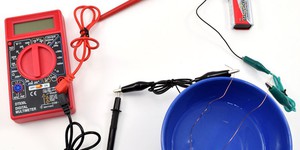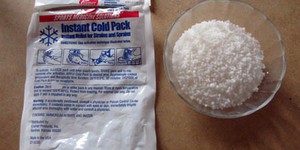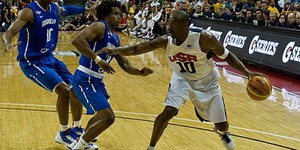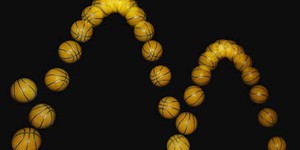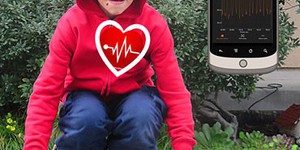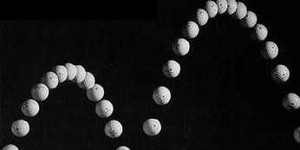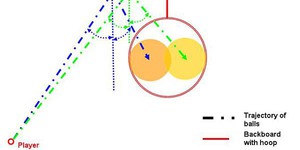Sports Science Science Projects (57 results)
Top athletes and coaches use a whole lot of science and engineering to improve performance and increase the chances of winning. Technologies like better tennis rackets, sleeker running and swimming outfits, and aerodynamic soccer balls, mean that current athletes are breaking world records left and right. Add to that better nutrition and science-based training regimes and you have an era of amazing athletes! Explore how science and engineering impact your favorite sport.
|
Select a resource
Sort by
|
The makers of sports drinks spend tens to hundreds of millions of dollars advertising their products each year. Among the benefits often featured in these ads are the beverages' high level of electrolytes, which your body loses as you sweat. In this science project, you will compare the amount of electrolytes in a sports drink with those in orange juice to find out which has more electrolytes to replenish the ones you lose as you work out or play sports. When you are finished, you might even…
Read more
Featured
Have you heard that garlic powder is supposed to inhibit the growth of bacteria? Which do you think would make a better disinfectant: a solution of garlic powder or a solution of bleach? This project shows you a straightforward way to compare the effectiveness of different disinfectants (or other antimicrobial agents), by measuring zones of inhibition on a culture plate.
Read more
Instant cold packs are popular with coaches and parents for treating minor bumps and bruises. The instant cold packs are not pre-cooled—you just squeeze the cold pack and its starts to get cold. So how does it work? In this chemistry science fair project, you will investigate the chemical reaction that occurs in instant cold packs.
Read more
New
Drones are small, fast, and maneuverable - this can make them very hard to knock down! Check out this Mark Rober video where he explores both how professional defense companies and some backyard YouTube engineers tackle the problem of knocking drones out of the sky. Can you take this engineering challenge on yourself? What methods can you devise to take down a drone? Which one works the best?
Drones can be expensive, and you probably do not want to risk damaging a $1,000 drone for your science…
Read more
Playing basketball can be hard work. Players not only constantly run around the court, but just dribbling the basketball takes a lot of effort, too. Why is that? It has to do with how the basketball bounces. When the ball hits the court, its bounce actually loses momentum by transferring some of its energy into a different form. This means that to keep the ball bouncing, players must continually put more energy into the ball. In this sports science project, you will determine how high a…
Read more
Have you ever noticed that when you drop a basketball, its bounce does not reach the height you dropped it from? Why is that? When a basketball bounces, such as on a basketball court, its bounce actually loses momentum by transferring energy elsewhere. This means that to dribble the basketball, players must continually replace the transferred energy by pushing down on the ball. But what happens to the "lost" energy? As we know from physics, energy is not really lost, it just changes form. One…
Read more
Have you ever seen a "Hail Mary" football pass, where the quarterback tries to throw the ball as far as possible to reach the end zone and score a touchdown? Or a last second game tying soccer goal from midfield? How far the ball will go does not just depend on how hard a player throws or kicks it; it also depends on the angle at which the player launches the ball. In this sports science project, you will investigate how launch angle affects the distance that a ball travels by filming…
Read more
New
Artificial intelligence (AI) programs can now generate photorealistic pictures of people who do not exist in the real world. How can you tell if a picture is of a real person or a fake, AI-generated person? What features of the picture do people use to decide whether the face is real or AI-generated? In this project, you will explore these questions as you ask volunteers to look at both real and AI-generated pictures of human faces.
Read more
Your heart starts beating before you are born and keeps right on going through your whole life. Over an average lifetime, the human heart beats more than 2.5 billion times. Keeping your heart healthy means eating right, not smoking, and getting regular exercise. Which of your favorite physical activities give your heart the best workout and help keep it fit? In this science project, you will use a smartphone equipped with a sensor app to visualize your heart rate and find out which…
Read more
Many sports use a ball in some way or another. We throw them, dribble them, hit them, kick them, and they always bounce back! What makes a ball so bouncy? In this experiment you can investigate the effect of air pressure on ball bouncing.
Read more
If you've ever played or watched basketball, you might already know that your chances of successfully banking a shot on the backboard are higher in certain positions on the basketball court, even when keeping the distance from the hoop the same. Ever wondered what would account for this? Do you think you could actually explain this using geometry? This science project will put your knowledge of geometry and algebra to good use. You will calculate and quantify how much more difficult it is to…
Read more
Swish! What a great sound when you hit the perfect shot and get nothing but net. Here's a project to get you thinking about how you can make that perfect shot more often.
Read more
So baseball's your game? Well, slugger, science and math abound in baseball. Just look at the zillions of "stats." In this project, you can produce some interesting baseball statistics of your own and perhaps settle a long-standing debate. You'll set up experiments at your local playing field to find out which type of bat is better, wood or aluminum. Play ball, and batter up!
Read more
|
Explore Our Science Videos
Gingerbread House STEM Challenge
Slow Motion Craters - STEM Activity
The First Cartoon: Make Your Own Thaumatrope!


